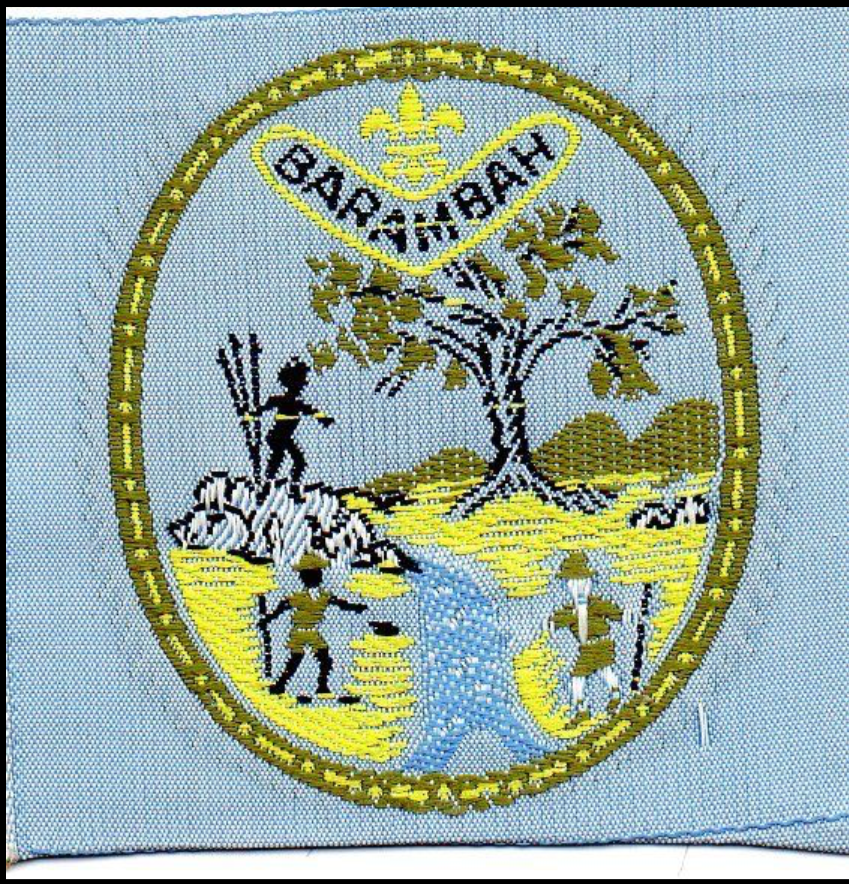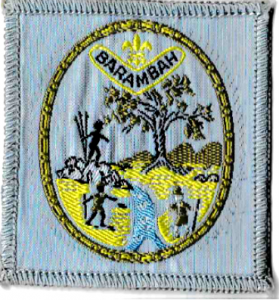
Barambah District (Ext)
Badge Description
The shape of the badge is that of a “Heliman” (aboriginal shield), which represents Goomeri (Gumarri), where the local aboriginal tribes secured corkwood to make their Helimans. [4, 11]
White scout and Aboriginal scout crossing Barambah Creek , which is the life blood of the district, to shake hands, which represents the welcoming of aboriginal Australians into the world brotherhood of Scouting.
The moss growing on the rocks along the stream’s banks represent the town of Morgon, whose name means “moss growing on rock”.
The tree is an apple tree, representing the town of Kilkivan (Gilgiven) meaning the “tree which was named by Europeons – apple tree”.
To the right of the tree is an ant bed with bones on top, which represents the town of Proston, which was named after a local leasehold, which was established in 1846.
World rope link in Gold
The badge was designed by the local Aboriginees Scout leaders from the settlement at Cherbourg and Murgon [4, 11]
The badge was first issued in March 1963 [4]
Previous Badge Variations
The following are variations of the badge:
 |
 |
|
Type = Woven bound, Bluish Grey border Scout logo design for tomorrow in knot |
Type = Woven bound, Grey border
|
|
53 x 63 mm; 50 x 55 mm |
50 x 53 mm; 50 x 55 mm |
| Ext | Ext |
History
Barambah comes for the Wakka Wakka aboriginal word “Buranba” which means “Westerly wind [1, 2]. The district is named after “Barambah Creek”, which ran through the district and is in the locality of Cherbourg. Cherbourg was originally known as Barambah.
Barambah District was formed in 1960/61 when it split from South Burnett district (i.e., mentioned in the Branch Annual Report 1962/63, but not mentioned on Branch Annual Report 1958/59) and the first District Commissioner was H. Nichols [2, 3]. It was absorbed into Bunya district in the 1970s [4]. It estimated that the district closed just after 1972, as training calendars mentioned Barambah district until up to May 1972, and from 1973 onwards, Gympie district and Beaver Masters districts are instead mentioned as training sites with no mention of Barambah district [5, 6, 7].
The district was also part of the South East Queensland Zone, which was administered by Branch Headquarters in Brisbane, and districts were supported by Field Commissioners [8]. In 1972, the districts within this Zone included: Maryborough, Maheno, Gympie, Cooroora, Beaver Masters, Nambour, D’Agular Range, Murrumba, Bunya, Barambah, Condamine, Dolphin, South Coast, Stradbroke Island and Beaudesert districts
Groups
Barambah District Groups (1962) Proston Scout Group, Goomeri Scout Group, Cherbourg Scout Group, Kilkivan Scout Group [9].
Barambah District Groups (1971): Goomeri Scout Group, Murgon Scout Group, Proston Scout Group [10]
References
- Barambah (Wakka Wakka) – from ‘Buranba’ which means ‘Westerly wind’. (30/10/2018) Retrieved from: http://www.slq.qld.gov.au/resources/atsi/languages/queensland/southeast-queensland-placenames
- Australian Boy Scouts Association, Queensland Branch (1959). Annual Report 1958-1959.
- Australian Boy Scouts Association, Queensland Branch (1963). Annual Report 1962-1963.
- Haskard, D. (1983). The complete book of Australian Scout badges: Part 2, Queensland and Papua New Guinea. Chatswood, NSW: Badgophilist Publications. p. 2.
- Scouting in Queensland (1972). Training Information. Vol. 11 (4), May, p. 19.
- Scouting in Queensland (1973). Training Information. Vol 12 (1), Jan-Feb, p. 23.
- Scouting in Queensland (1973). Training Information. Vol. 12 (5), June p. 19.
- Scouting in Queensland (1972). “South-East Qld Zone Conference”. Vol 11 (6), July, p. 5.
- The Queensland Scouter (1962). “Know your districts”. Vol 1 (10), October, p. 3.
- The Boy Scouts Association, Queensland Branch (1971). Area, group and district directory 1971. Abel & Co.
- Irons, J. (May, 1964) Australian Scout Badges. Glenorchy (GSM, 1st Prince of Wales Group), Tasmania
